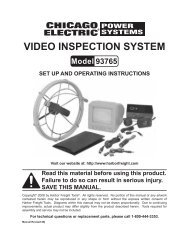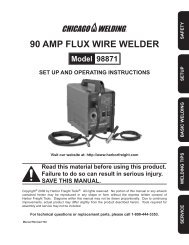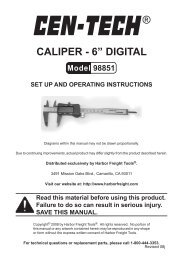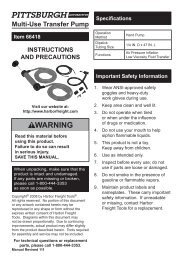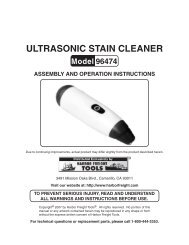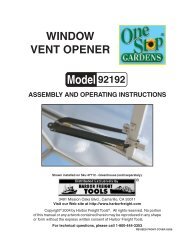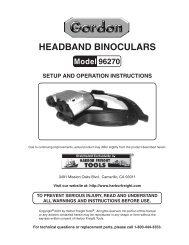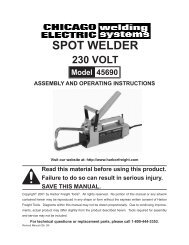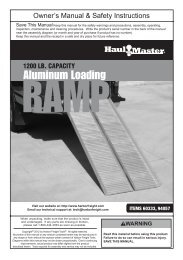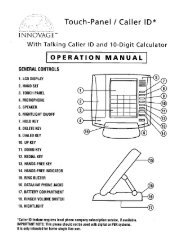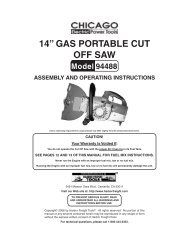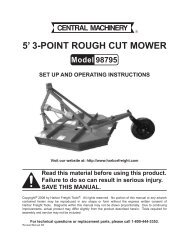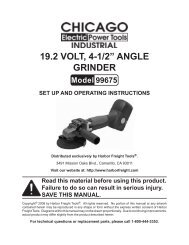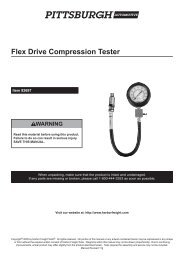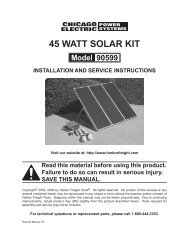AC/DC TIG WELDER - Harbor Freight Tools
AC/DC TIG WELDER - Harbor Freight Tools
AC/DC TIG WELDER - Harbor Freight Tools
Create successful ePaper yourself
Turn your PDF publications into a flip-book with our unique Google optimized e-Paper software.
SPECIFIC SAFETY RULES<br />
1. Maintain a safe working environment. Keep the work area well lit. Make sure<br />
there is adequate surrounding workspace. Always keep the work area free of<br />
obstructions, grease, oil, trash, and other debris. Do not use the Welder in areas<br />
near flammable chemicals, dusts, and vapors.<br />
2. Maintain labels and nameplates on the Welder. These carry important<br />
information. If unreadable or missing, contact <strong>Harbor</strong> <strong>Freight</strong> <strong>Tools</strong> for a<br />
replacement.<br />
3. Prevent eye injury and burns. Wearing and using personal safety clothing and<br />
safety devices reduce the risk of injury. Wear ANSI approved safety impact<br />
eyeglasses with a welding helmut featuring at least a number 10 shade lens<br />
rating. Leather leggings, rubber soled, fire resistant shoes or boots should be<br />
worn when using this Welder. Do not wear pants with cuffs, shirts with open<br />
pockets, or any clothing that can catch and hold molten metal or sparks. Keep<br />
clothing free of grease, oil, solvents, or any other flammable substances. Wear<br />
dry, insulating gloves and protective clothing. Wear an approved head covering to<br />
protect head and neck. Use aprons, cape, sleeves and shoulder covers, and bibs<br />
designed and approved for welding procedures. When welding overhead or in<br />
confined spaces, wear flame resistant ear plugs or ear muffs to keep sparks out of<br />
ears.<br />
4. Avoid overexposure to fumes and gases. Always keep your head out of the<br />
fumes. Do not breathe the fumes. Use enough ventilation or exhaust, or both, to<br />
keep fumes and gases from your breathing zone and general area. Where<br />
ventilation is questionable, have a qualified technician take an air sampling to<br />
determine the need for corrective measures. Use mechanical ventilation to<br />
improve air quality. If engineering controls are not feasible, use an approved<br />
respirator. Work in a confined area only if it is well ventilated, or while wearing an<br />
air-supplied respirator. Follow OSHA guidelines for Permissible Exposure Limits<br />
(PEL’s) for various fumes and gases. Follow the American Conference of<br />
Governmental Industrial Hygienists recommendations for Threshold Limit Values<br />
(TLV’s) for fumes and gases. Have a recognized specialist in Industrial Hygiene<br />
or Environmental Services check the operation and air quality and make<br />
recommendations for the specific welding situation.<br />
5. Do not perform welding or cutting operations near chlorinated hydrocarbon<br />
vapors produced by degreasing or painting. The heat generated by arc rays<br />
can react to form phosgene, a highly toxic gas.<br />
6. Irritation of the eyes, nose, and throat are symptoms of inadequate<br />
ventilation. Take immediate steps to improve ventilation. Do not continue<br />
operations if symptoms persist.<br />
SKU 91149 For technical questions, please call 1-800-444-3353. PAGE 6



